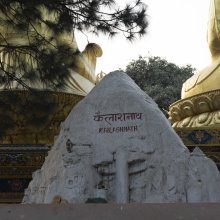Kailasa, Kailāsa, Kailāśa, Kailasha: 32 definitions
Introduction:
Kailasa means something in Buddhism, Pali, Hinduism, Sanskrit, Jainism, Prakrit, the history of ancient India, Marathi. If you want to know the exact meaning, history, etymology or English translation of this term then check out the descriptions on this page. Add your comment or reference to a book if you want to contribute to this summary article.
Kailasa has 30 English definitions available.
The Sanskrit term Kailāśa can be transliterated into English as Kailasa or Kailasha, using the IAST transliteration scheme (?).
Images (photo gallery)
(+6 more images available)
Languages of India and abroad
Sanskrit dictionary
[Deutsch Wörterbuch]
Source: Cologne Digital Sanskrit Dictionaries: Böhtlingk and Roth Grosses Petersburger WörterbuchKailāsa (कैलास):—m. Nomen proprium eines Berges, des Sitzes von Kuvera und Śiva. [Amarakoṣa 1, 1, 1, 66.] [Trikāṇḍaśeṣa 2, 3, 1.] [Hemacandra’s Abhidhānacintāmaṇi 1028.] [Lassen’s Indische Alterthumskunde I, 33. fgg.] [841. fg.] [Mahābhārata 3, 503.] kailāsanilayo dhanādhyakṣaḥ [?1697. Harivaṃśa 9737. 11447. 12005. 12419. 12851. Rāmāyaṇa 3, 36, 16. 54, 5. 4, 44, 27. Varāhamihira’s Bṛhajjātaka S. 14, 24 in Weber’s Verzeichniss 241. Mṛcchakaṭikā 173, 16. Meghadūta 11. 59.] uttaraṃ śikharaṃ tasya (himavataḥ) kailāsākhyo mahāṃgiriḥ [Kathāsaritsāgara 1, 15.] [Rājataraṅgiṇī 1, 57. 3, 375.] [Viṣṇupurāṇa 172.] [Bhāgavatapurāṇa 5, 16, 28.] kailāsaśailendraśikharasthitamīśvaram [Mārkāṇḍeyapurāṇa 23, 59.] Mit śa geschrieben erscheint das Wort [Indralokāgamana 1, 40] [?(Mahābhārata 3, 1753] mit sa). [Rāmāyaṇa 1, 38, 10.] [Raghuvaṃśa 2, 35. 5, 28. 12, 89] (die Calc. Ausgabe überall sa). kailāsanātha ( [Vikramorvaśī 3.] [Raghuvaṃśa 5, 28]) und kailāsaukas ( [Hemacandra’s Abhidhānacintāmaṇi 190]) Beinamen von Kuvera; kailāsaniketana ( [KAVIKALPAL. im Śabdakalpadruma]) kailāśapati und kailāśaśikharavāsin ( [Śivanāmasahasra]) Beinn. von Śiva. ādityapurāṇīyakailāsasaṃhitā Titel eines [UPAPURĀṆA] [Weber’s Indische Studien 1, 469.]
--- OR ---
Kailāsa (कैलास):—, kapardī kailāsam (mṛgayate) [Spr. 4705.] [KṢITĪŚ. 24,9.] [Oxforder Handschriften 26,a,45. 41,a,35. 77,b,26.] gamana [116,b,5.] kailāsābhigamana [79,a,17.] yuddha, vijaya [345,a,41.] — Bez. einer best. Tempelform [Varāhamihira’s Bṛhajjātaka S. 56, 17. 21.]
Source: Cologne Digital Sanskrit Dictionaries: Sanskrit-Wörterbuch in kürzerer FassungKailāsa (कैलास):—m. —
1) Nomen proprium eines Berges , des Sitzes von Kubera und Śiva. —
2) eine best. Tempelform.
Sanskrit, also spelled संस्कृतम् (saṃskṛtam), is an ancient language of India commonly seen as the grandmother of the Indo-European language family (even English!). Closely allied with Prakrit and Pali, Sanskrit is more exhaustive in both grammar and terms and has the most extensive collection of literature in the world, greatly surpassing its sister-languages Greek and Latin.
See also (Relevant definitions)
Starts with (+18): Kailacam, Kailacanatan, Kailasa acarya, Kailasa yati, Kailasacala, Kailasacalayati, Kailasachala, Kailasaka, Kailasakhanda, Kailasakudhara, Kailasanagara, Kailasanatha, Kailasanathar Temple, Kailasaniketana, Kailasaniketanatha, Kailasanilaya, Kailasapandita, Kailasaparvata, Kailasapati, Kailasapura.
Ends with: Dakshinakailasa, Jnanakailasa, Kelikailasa, Mahakailasa, Shrikailasa.
Full-text (+862): Kelasa, Rajatadri, Ganaparvata, Ganacala, Rajataprastha, Kuveracala, Kailasaniketana, Sphatikacala, Shamkaralaya, Kailasaukas, Tridashashaila, Rupyacala, Haradri, Ashtapada, Brahmapuri, Shivalaya, Atmalinga, Shivaloka, Shvetadri, Kayilai.
Relevant text
Search found 106 books and stories containing Kailasa, Kailāsa, Kailāśa, Kailāsā, Kaiḷāsa, Kailasha; (plurals include: Kailasas, Kailāsas, Kailāśas, Kailāsās, Kaiḷāsas, Kailashas). You can also click to the full overview containing English textual excerpts. Below are direct links for the most relevant articles:
Garga Samhita (English) (by Danavir Goswami)
Verse 2.24.44 < [Chapter 24 - The Story of Asuri Muni in the Rāsa-dance Pastime]
Verse 2.10.6 < [Chapter 10 - Description of Śrī Kṛṣṇa’s Herding the Cows]
Verse 6.10.17 < [Chapter 10 - In the Description of the Gomatī River, the Glories of Cakra-tīrtha]
Sanskrit sources of Kerala history (by Suma Parappattoli)
9. Kavyadarsa (Keralavamsa) < [Chapter 6 - Miscellaneous Sanskrit works bearing on Kerala history]
6.1. Prasastis of Narayana Bhatta < [Chapter 2 - Historical details from Mahatmyas and Prashastis]
Brihad Bhagavatamrita (commentary) (by Śrī Śrīmad Bhaktivedānta Nārāyana Gosvāmī Mahārāja)
Verse 1.2.92 < [Chapter 2 - Divya (the celestial plane)]
Verse 2.3.58-59 < [Chapter 3 - Bhajana (loving service)]
Verse 1.2.93-94 < [Chapter 2 - Divya (the celestial plane)]
Bhakti-rasamrta-sindhu (by Śrīla Rūpa Gosvāmī)
Verse 4.9.31 < [Part 9 - Incomplete Expression of Mellows (rasābhāsa)]
Verse 4.9.27 < [Part 9 - Incomplete Expression of Mellows (rasābhāsa)]
Verse 4.8.59 < [Part 8 - Compatible & Incompatible Mellows (maitrī-vaira-sthiti)]
The Skanda Purana (by G. V. Tagare)
Chapter 52 - The Commanding Peak of the Mountain < [Section 3 - Arbuda-khaṇḍa]
Chapter 9 - The Rise of Bhava < [Section 2 - Vastrāpatha-kṣetra-māhātmya]
Chapter 8 - Propitiation of Rudra by Brahmā < [Section 2 - Vastrāpatha-kṣetra-māhātmya]
Vastu-shastra (5): Temple Architecture (by D. N. Shukla)
Temples at Ellora and Elephanta < [Chapter 12 - History of Hindu Temples (Prāsādas and Vimānas)]
Chapter 5 - Pre-Samarāṅgana Classification of Temples
Related products






